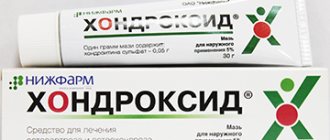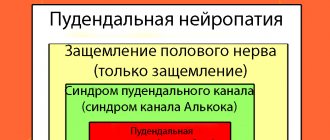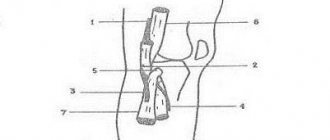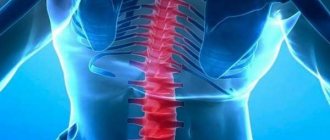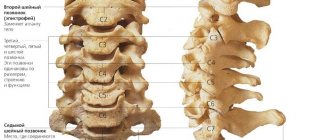The sciatic nerve is the largest in the human body. That is why any damage to the nerve ending - inflammatory, infectious, mechanical - provokes the occurrence of painful sensations throughout the body. This process has a medical term - sciatica. How to deal with excruciating pain that spreads to the lower back, lower limbs, hips, what are the symptoms and treatment for sciatica - we’ll look at it later in the article.
What is sciatica?
Sciatica (sciatica) is not an independent disease, but a complex of symptoms resulting from compression, irritation or exit from the sciatic nerve canal. Due to the length and branching of the nerve, pain can occur not only at the point of injury, but also at a distance from it.
In the vast majority of cases, sciatica is unilateral. If the disease begins with a lumbago in the lower back, then it is called lumboischialgia.
What is a pinched sciatic nerve?
Inflammation of the sciatic nerve is a defensive reaction to the action of an irritant, manifested in severe pain in the lumbar region, buttocks and legs.
The sciatic nerve is one of the largest in the human body. It is he who has increased sensitivity and becomes inflamed more often than others. Its function is to be responsible for the movement of the lower extremities.
A nerve is a bundle of nerve fibers that are covered with a membrane called the endoneurium. The endoneurium, in turn, is penetrated by the smallest blood vessels - capillaries. Below it is a second layer called the perinervium. It also has vessels, but they are larger. Each vessel is covered with a layer of connective tissue; it is this that protects the sciatic nerve from various types of damage, acting as a kind of shock absorber.
The nerve itself is located in the neural tube, which is very dense, as it is also covered with connective tissue called epinervium.
In medicine you can also find the term sciatica, neuritis, sciatic nerve neuropathy or sciatica, which characterizes the same condition. It is worth understanding that inflammation of the sciatic nerve is not a separate disease, but a symptom that signals problems in the lumbar and sacral areas.
This largest nerve originates in the pelvic region, in the lumbar spine. Its length is large, so it covers most parts of the lower body. From the sacral region, a branch of the nerve enters the pelvis through a special opening called the infrapiriform opening. Next, the nerve stretches under the gluteal muscle and branches into smaller processes that penetrate all the gluteal and thigh muscles. In addition, it affects all joints in this area.
Going down to the popliteal fossa, the nerve branches into a pair of large processes. They are called the tibial branch and the fibular branch. Thanks to these branches, the sensitivity of the skin of the lower leg and foot, as well as all joints and muscles located in the lower extremities, is ensured.
The sciatic nerve stretches along the entire length of the leg, thereby causing painful sensations throughout the lower limb during inflammation and any other damage.
The sciatic nerve consists of several pairs of nerves that are located in the spine. All these nerves are surrounded by dense connective tissue. Where is the sciatic nerve located?
- This important nerve originates in the lower back or pelvis.
- The sacral nerve plexus is exited through a special opening in the pelvis called the infrapiriform opening.
- The nerve is brought to the surface of the thigh under the gluteus maximus muscle. It then descends and splits into several small branches that monitor the sensitivity of the gluteal and thigh muscles.
- The nerve then travels to the popliteal fossa, where it divides into the tibial and peroneal branches. This network of nerves monitors the sensitivity of the joints, muscles, and skin of the feet and knees located in this area.
What is sciatica? Neuritis of the sciatic nerve is called sciatica. With this disease, an inflammatory process begins in the nerve endings, and the person experiences severe pain from the lower back to the ankle joint.
A pinched sciatic nerve, commonly known as sciatica or sciatica, is severe pain felt along one of the two sciatic nerves.
Located at the back of each leg, they are the largest nerves in the body (see diagram below). They connect the spine in the lower back, at the level of the lumbosacral spine (just above the tailbone).
The pain mainly affects the buttocks and thighs, and often spreads to the foot area. Most often, the pain affects only one side of the body.
Pain due to a pinched sciatic nerve can occur suddenly—for example, when you bend over or lift something heavy.
What is the danger?
The appearance of sciatica should not be taken lightly. She never just appears. Once it appears, it will constantly remind you of itself. The situation will become more complicated from attack to attack, gradually immobilizing the person.
Every movement will cause unbearable pain, difficult to relieve with medications. In particularly severe cases, sciatica can lead to loss of sensitivity and dysfunction of the pelvic organs (fecal and urinary incontinence).
Prevention
To prevent pinching of the sciatic nerve from developing into neuralgia or happening again, it is necessary to strictly follow the doctor’s recommendations for the prevention of sciatica:
- Treatment of scoliosis in childhood;
- Attending manual therapy sessions to eliminate spinal deformity;
- Constant physical therapy, gymnastics and minimal physical activity;
- Taking vitamin complexes, immunostimulants;
- Strengthening the spine;
- Control of physical activity;
- Diet;
- Rejection of bad habits;
- Treatment of pathologies and chronic joint diseases.
Also remember that sedentary work negatively affects the condition of the sciatic nerve and the development of sciatica, so every hour and a half you need to do pull-ups, gymnastics and use a special chair and back pillows.
The same goes for choosing bedding, sleeping position and wearing warm clothes in cold weather to prevent hypothermia.
If there is an infection, fungus or pathogenic bacteria in the body, then get rid of it immediately, otherwise the sciatic nerve will suffer and sciatica will appear.
Be sure to watch the video on how to relieve the pain of sciatic nerve sciatica:
Causes
The development of sciatica occurs against the background of the underlying disease. The level of pain and the likelihood of recovery depend on it. The main reasons causing the development of sciatica include:
- Injuries.
- Protrusions and hernias of the vertebrae.
- Ankylosing spondylitis.
- Spondylolisthesis.
- Spinal stenosis.
- Piriformis syndrome.
- Tumors.
- Pregnancy.
- Thrombosis.
- Diabetes.
- Hypothermia.
- Lifting weights.
All these conditions can cause the development of pathological processes in tissues, and involve the roots of the sciatic nerve.
Lumbago and sciatica
Speaking about the combination of lumbago and sciatica, the pain syndrome spreads to the entire leg, accompanied by spasms and fever.
In addition, the following symptoms are observed:
- A sharp and aching pain in the area of the entire sciatic nerve, the sensation lasts for at least half an hour, and can be sharp, sharp, stabbing and aching. Sometimes the lumbago is felt for a whole week;
- Spasms;
- Decreased physical activity.
Helpful tip:
Recommended posture during an attack of lumbago
Symptoms
The first and main sign of compression of the sciatic nerve is pain of varying degrees of intensity . It can be either localized in a specific area or spread throughout the entire leg.
In addition to pain, sciatica can manifest itself with the following symptoms:
- Back muscle tension.
- Pain in the gluteal muscles, worse when sitting.
- Tingling or burning in the leg.
- Sensory disturbances (paresthesia, hyperesthesia).
- Movement disorders (weakness in the leg, lameness, immobility).
- Cramps.
- Incontinence of feces and urine.
Symptoms may appear with varying degrees of intensity. The strength of their manifestation directly depends on the severity of the underlying disease.
Ointments for sciatica
Ointments for sciatica
Topical medications or ointments for sciatica differ in the nature of the effect of the active components in the composition. The following ointments can be used:
- homeopathic external remedies;
- distracting ointments to relieve pain;
- chondoprotectors;
- non-steroidal ointments as painkillers;
- combined ointments - anti-inflammatory and analgesic.
The ointment is an integral part of complex therapy. Using only external remedies will not bring much benefit in the treatment of sciatica.
Diagnostics
To make an accurate diagnosis, consultation with a neurologist is necessary. The basis for diagnosing sciatica is:
- Blood and urine tests (general and biochemical).
- X-ray, CT, MRI.
- Electroneurography (ENG) and electromyography (EMG).
Laboratory tests of blood and urine show the level of inflammation and the degree of immune response in concomitant diseases, and indicators of hardware research methods visualize spinal pathologies.
ENG and EMG procedures are not prescribed to all patients. In doubtful cases, when it is difficult to accurately determine the location, duration and extent of nerve damage, ENG and EMG may be more effective research methods. In addition, these procedures can be used to monitor the effectiveness of the selected treatment regimen.
Treatment
Therapy should begin with eliminating the root cause. But, since treatment of the underlying disease may take several months, it is necessary to help the person cope with pain and restore lost functions. For these purposes, a combined treatment regimen , including physiotherapy and painkillers and anti-inflammatory medications.
Physiotherapeutic treatment methods:
- UHF.
- Diadynamic therapy.
- Aplipulse therapy.
- Neurostimulation.
- Phonophoresis.
- Massotherapy.
- Acupuncture.
- Vacuum therapy.
Physiotherapy using currents has a number of limitations and contraindications. It is not recommended to carry out these treatment methods without consulting your doctor.
Drug therapy includes taking drugs from the NSAID (Diclofenac, Indomethacin, Ibuprofen), painkillers (Renalgin, Analgin), vitamins B, C, E, as well as epidural injections of steroid drugs, and various types of injection blockades.
In the acute period, drugs of the NSAID group and painkillers are prescribed in the form of injections. As the pain subsides, a transition to the tablet form is made.
In severe cases, when conservative treatment methods do not bring results, you have to resort to surgical intervention. If sciatica is caused by a herniated disc, a microdiscectomy , and if there is severe stenosis, a laminectomy . Surgical treatment methods also include neurolysis and suturing of the sciatic nerve trunk. All these procedures are quite traumatic, and do not always live up to the expectations placed on them. That is why they are resorted to only in extreme cases.
How to treat sciatica with acupuncture?
The safest method of treating this disease is massage. During an exacerbation, only a relaxing massage is prescribed, since therapeutic massage is contraindicated for pain. How to treat sciatica with massage? Not only the back is massaged, but also the legs and arms, depending on the type of disease (upper or lower). Massage will help relax muscles during spasm and promote the outflow of lymph and blood.
We invite you to read: Causes and treatment of arthrosis of the 1st degree; a comprehensive description of the disease
Acupuncture for sciatica gives excellent results. The patient relaxes and pain of nervous origin is treated. How to treat sciatica with acupuncture?
How to treat sciatica with acupuncture?
If the pain is acute, then you need to influence the point energetically. It is enough to move your palms, as if suspended, in the area of pain. Stimulation is resumed when the need arises.
This disease in pregnant women usually appears in the later stages, as the sciatic nerve is compressed by the growing uterus. The question of how to treat sciatica during pregnancy is difficult to answer even for a doctor.
- After all, many treatment methods are harmful to the fetus.
- But in this case, the use of external remedies, both traditional and traditional medicine, is excellent.
- However, pay attention to the composition of ointments so that they contain natural ingredients.
- You can carry out light massage procedures, make warm compresses and rub with alcohol-containing tinctures - hot pepper or lilac.
Lumbago with sciatica is characterized by severe pain, especially during movement. In the body, inflammation occurs in the cartilage tissue of the lower back. Typically, sciatica is always a consequence of lumbago. These two diseases are interrelated.
How to treat lumbago with sciatica? Here are some ways:
- Drug therapy should only be prescribed by a doctor. Aimed at relieving inflammation.
- Reflexology is performed by inserting special needles into acupuncture points.
- Therapeutic exercise prevents relapses, strengthens the muscle corset, restores mobility and improves blood circulation.
- Physiotherapeutic procedures - inflammation is relieved and function in the lumbar region is restored.
To prevent such a disease, you need to protect yourself from hypothermia and severe stress on the spine. It is important to lead a healthy lifestyle and exercise.
There is no clear answer to the question of how long sciatica lasts and is treated. For some people, relief occurs after 7-10 days of treatment, while for others it takes at least a month. The main thing is not to delay the course of the disease and consult a doctor in a timely manner. Otherwise, the disease may become chronic, and the pain will constantly make itself felt.
As mentioned above, the disease cannot be started. If the first symptoms appear, you should consult a doctor. Sciatica can be cured forever if you constantly take care of yourself: lead a healthy lifestyle, eat right, exercise, protect yourself from hypothermia, and so on.
There are two doctors who treat inflammation of the sciatic nerve. This is a neurologist who prescribes pharmacological symptomatic therapy, and a chiropractor who eliminates the very cause of the pathology.
A vertebrologist can also help
Author of the article: Sokov Andrey Vladimirovich | Neurologist
Education: In 2005, she completed an internship at the First Moscow State Medical University named after I.M. Sechenov and received a diploma in the specialty “Neurology”. In 2009, she completed her postgraduate studies in the specialty “Nervous Diseases”.
Other doctors
‹
22 reasons to love bananas. What happens if you eat them every day?
Is it true that you need to cleanse your body? Myths and proven facts!
›
Pronounced symptoms or the first harbingers of the disease are a reason to consult a specialist. It is necessary to make an accurate diagnosis, because the specifics of treatment will depend on the identified causes of inflammation of the sciatic nerve. An X-ray or CT scan, MRI or electroneuromyography will help determine exactly what is causing sciatica.
At the same time, the neurologist examines the degree of damage to the sciatic nerve, conducting special tests for motor reflexes:
- Achilles tendon,
- knee joint,
- checks for the presence of Lassen symptoms (pain on the back of the thigh and lower leg when lifting a straight leg up and forward independently), Bonnet (the same procedure, only the doctor lifts the leg).
Having compared the symptoms, found out the cause of the disease, the degree of damage to the nerve endings and the severity of the inflammation, the specialist prescribes a comprehensive treatment, which includes:
- Drug treatment.
- Prescribing a set of physical exercises, massages and special therapy.
- Physiotherapy and radiology (in rare cases).
- Homeopathic treatment. Special homeopathic ointments and creams will help relieve pain symptoms and reduce inflammation of the sciatic nerve.
- Folk remedy.
How to treat inflammation of the sciatic nerve? The first aid for a sharp exacerbation of sciatica will be painkillers:
- analgin;
- derivatives with a pronounced direction of action: tempalgin - pain symptoms subside as a result of the action of tempidine - a mild tranquilizer;
- sedalgin - codeine and paracetamol have an invigorating effect on the nervous system, relieving inflammation of the nerve roots;
- baralgin - antispasmodics in the composition remove muscle inflammation, relieving spasm of the sciatic nerve;
- pentalgin.
Non-steroidal anti-inflammatory drugs (NSAIDs) – tablets, injections for severe pain, ointments will be mandatory in the treatment of sciatic nerve entrapment:
- Diclofenac (tablets) – anesthetizes and relieves inflammation, pain, swelling. Injections for inflammation of the sciatic nerve of this drug are more effective, but the degree of influence of side effects on the liver and kidneys increases. Therefore, they are prescribed intramuscularly or intravenously by a doctor with a minimum interval of 12 hours.
- Movalis is a very powerful drug that quickly relieves pain symptoms. Quickly reduces inflammation of the sciatic nerve. The presence of significant side effects requires taking the tablets under medical supervision for no more than 5 days.
- Ibuprofen, Nise, Nurofen are NSAIDs with less pronounced effects. They are good because they affect the peripheral nervous system, relieving inflammation, and muscles, relaxing and removing spasms.
- Corticosteroids are prescribed for long-term, persistent pain symptoms. These are hormonal agents that relieve swelling and inflammation of the sciatic nerve.
For pregnant women, the doctor will recommend a special treatment for inflammation of the sciatic nerve. Taking most medications during this period negatively affects the health of the expectant mother and child, so it is strictly prohibited to use medications without consulting a doctor. The most gentle medicine would be painkillers - suppositories. Homeopathy will also become one of the possible and safe treatment options.
The acute period of inflammation of the sciatic nerve in most cases lasts from 5 to 10 days. During this time, it is necessary to ensure a reduction in physical activity and rest for the lumbosacral region, in other words, it is more in a horizontal position, preferably on a hard orthopedic surface. The subsidence of symptoms is not a reason to increase sports activity.
We invite you to read: Treatment of rheumatoid arthritis - 12 modern methods
The neurologist determines the time when it is possible to begin treatment of chronic sciatica with therapeutic exercises and physical exercises. Based on the identified causes of inflammation of the sciatic nerve and symptoms, the physiotherapist develops a special program. For pregnant women, it is drawn up by a medical commission, which necessarily includes a gynecologist, therapist, and physiotherapist. Yoga, Pilates, and swimming will be useful.
The use of massage as a treatment method for acute symptoms of inflammation of the sciatic nerve is very careful: stroking and light rubbing. When the pain subsides, you can use more intense techniques - kneading and patting. Essential oils and warming ointments will be a good help. The result will be improved blood flow to pinched nerve endings, relieving tightness and muscle spasms, stimulating the production of endorphins, and reducing swelling.
Reflexology methods - acupuncture, manual acupressure - relieve pain symptoms of inflammation of the sciatic nerve. Long-term treatment with needles (up to 3 months) can not only eliminate the manifestation of the disease, but also cope with the causes of its exacerbation for a long time. Oncology, skin lesions, pregnancy are contraindications to the use of this type of therapy.
Blockade
In some cases of symptoms of sciatica, when NSAIDs and analgesics do not work, the doctor prescribes novocaine blockades. This drug blocks nerve impulses to the sciatic nerve, relieving the symptoms of inflammation. Nervous behavior (excitement or apathy), inability to move, feeling of pain both standing and lying down are grounds for prescribing a blockade with anesthetics.
Warming ointments will help relieve inflammation of the sciatic nerve at home. Turpentine, camphor ointment, beeswax - will perfectly warm the inflamed area, improve blood flow to the nerve endings, and remove spasms. A tincture of red pepper and vodka, used as a compress, improves the conductivity of the sciatic nerve and promotes the production of hormones - endorphins.
After diagnosis, the neurologist will prescribe you treatment consisting of the following procedures:
- Physiotherapy. It helps to reduce or even get rid of pain, but it does not treat the underlying cause, but rather affects the symptoms. Physiotherapeutic procedures are prescribed: Laser therapy;
- Electrophoresis;
- Magnetic or UHF therapy.
Treatment at home
The basis of home treatment for sciatica is various types of rubbing and compresses.
- 100 g of acacia flowers + 300 ml of vodka, leave in a warm place for 1 week. Strain the resulting mixture. Rub into the affected area as needed.
- Mix honey and black radish juice in a 3:1 ratio. Rub the resulting mixture onto the sore area until completely absorbed. The course of treatment is 7-10 days.
- Knead the dough from 1 cup of flour and 1-2 tablespoons of warm honey. Form the dough into a flat cake and apply it to the sore spot overnight. The cake must be covered with polyethylene and secured with a bandage. The course of treatment is 7-10 days.
- Mix turpentine and water in a 1:2 ratio. Moisten a long piece of bread with the resulting solution and apply it to the sore spot. Wrap in plastic. The procedure takes no more than 10-15 minutes to avoid burns.
These and many other traditional medicine recipes relieve pain by improving local blood circulation. But, they are not able to eliminate the main cause of compression. Treatment with folk remedies must be agreed with your doctor.
Sciatica - treatment with folk remedies: recipes
Rub recipes:
- Grind the horse chestnut seeds.
- Take 2 tablespoons of these crushed seeds and pour half a liter of boiling water.
- Place in a steam bath and keep for 15 minutes.
- Then cool, strain and take 100 ml every day.
You can also infuse flowers, but they must first be dried. Then do the following:
- Pour 1 tablespoon of dried chestnut flowers with a glass of boiling water.
- Leave until the water cools, strain.
- Take this infusion throughout the day, dividing it into 3 parts.
Such infusions should be used in combination with other treatment methods.



